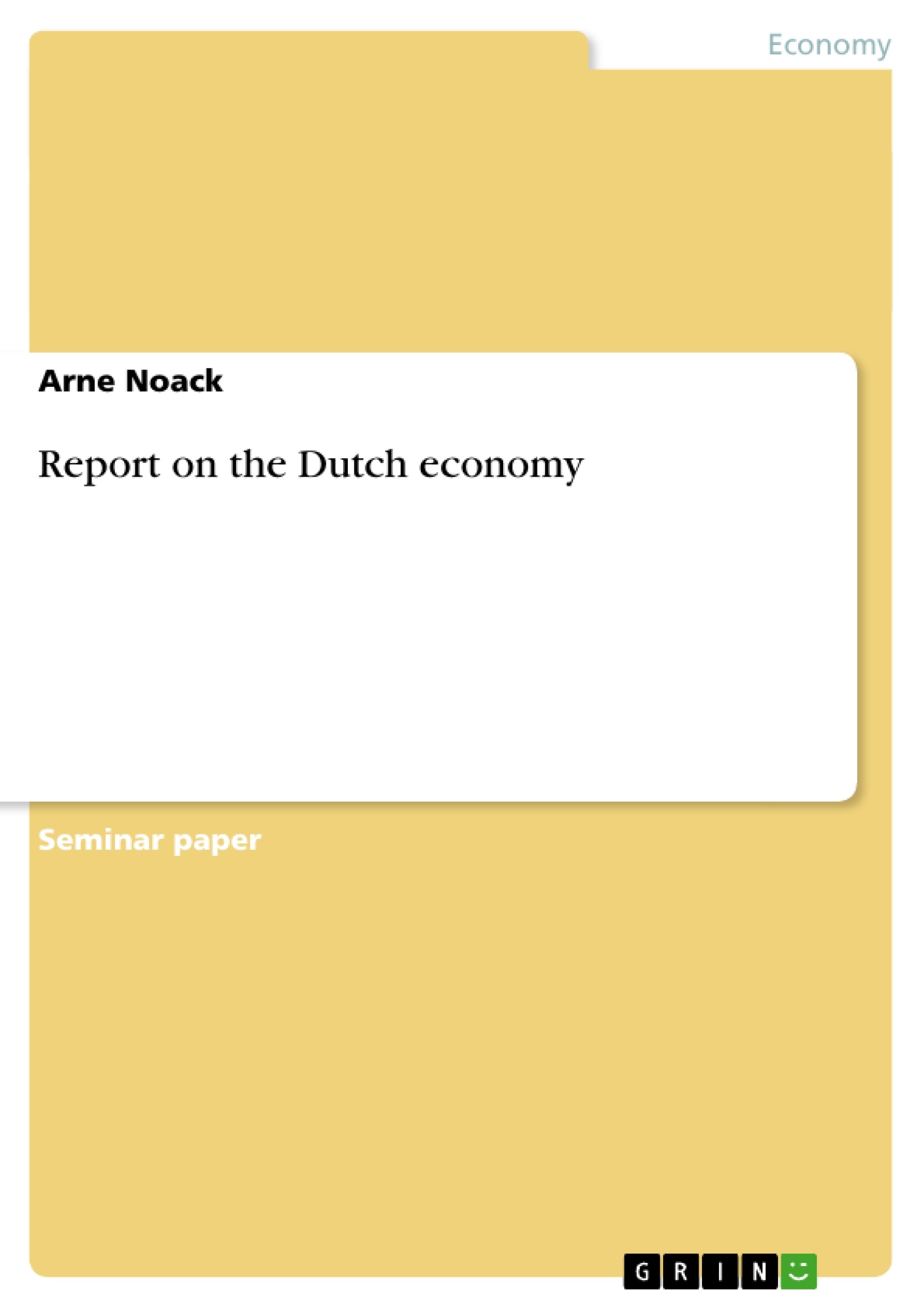The Dutch empire had played a quite big role in the worlds politics and economics in the end
of the 18th and the beginning of the 19th century. The Netherlands held a prospering empire
with flourishing trade. With the beginning of the Industrialisation the Netherlands fell back in
international competitiveness. The Dutch economy experienced a great boom 1945 after the
second world war on the base of chemical and Electro-Industry. However the development of
the Netherlands differed from most European countries.
This essay intends to describe the Dutch economy during the 1990 to the millennium.
What production of goods is it specialised on and how is this production process organised? Is
this economy able to address the needs of the Dutch population or is there even a lack of some
goods?
The following report tries to find answers to these questions by highlighting specific attributes
of the Dutch economy. By describing the development of the past decade it might be possible
to give a brief forecast on the Netherlands’ level of prosperity for the forthcoming five years
in the end of this essay. The Netherlands are located in the West of Europe. Compared to the rest of the world, the
area of the Netherlands is relatively small with only 41 526 km2 , which means it takes ranks
no. 132 in the world scale. Nevertheless the inhabitants are relatively numerous with 16.1
million people in 2002. This creates a high population density of 386 inhabitants per km2.
As pointed out in the essay this fact creates a good market for the Dutch economy.
The neighbours are Belgium in the South and Germany in the East. The North Sea is located
on the Northwest coast of the country.
The Dutch capital is the Amsterdam, while the seat of the government is located in the city of
Den Haag. [...]
Contents
1. Introduction
2. Structure of the economy
3. Trade
4. Deficits of the Dutch economy
5. economic development
Abbildung in dieser Leseprobe nicht enthalten
1. Introduction
The Dutch empire had played a quite big role in the worlds politics and economics in the end of the 18th and the beginning of the 19th century. The Netherlands held a prospering empire with flourishing trade. With the beginning of the Industrialisation the Netherlands fell back in international competitiveness. The Dutch economy experienced a great boom 1945 after the second world war on the base of chemical and Electro-Industry. However the development of the Netherlands differed from most European countries.
This essay intends to describe the Dutch economy during the 1990 to the millennium.
What production of goods is it specialised on and how is this production process organised? Is this economy able to address the needs of the Dutch population or is there even a lack of some goods?
The following report tries to find answers to these questions by highlighting specific attributes of the Dutch economy. By describing the development of the past decade it might be possible to give a brief forecast on the Netherlands’ level of prosperity for the forthcoming five years in the end of this essay.
General Information about the country
The Netherlands are located in the West of Europe. Compared to the rest of the world, the area of the Netherlands is relatively small with only 41 526 km2 , which means it takes ranks no. 132 in the world scale. Nevertheless the inhabitants are relatively numerous with 16.1 million people in 2002. This creates a high population density of 386 inhabitants per km2.
As pointed out in the essay this fact creates a good market for the Dutch economy.
The neighbours are Belgium in the South and Germany in the East. The North Sea is located on the Northwest coast of the country.
The Dutch capital is the Amsterdam, while the seat of the government is located in the city of Den Haag.
The Netherlands have a flat geographical Structure. One quarter of the country is below sea level. The lowest point of the county is Zuidplaspolder (-7 m) and the highest point Vaalserberg (322 m).
Due to this, the danger of devastating floods is relatively high, which has an impact on Dutch politics and economy.
2. Structure of the economy
Short description of the Dutch economy
The Netherlands belong to one of the founding members of the European Economic Community (EEC). Due to the development in the European community, the EURO was introduced as flowing currency on January 1st 2002.
The economy is characteristic for stable industrial relation and a moderate Inflation. Due to the location of the country it plays an important role as a European transportation hub. Therefor the Netherlands have the highest density of roads relative to the size of the country in Europe.
The Dutch standards of living are high. The Netherlands are rated the highest country in Europe in the United Nations development index. One indication is the GDP per capita, which is well above EU-average.
The main characteristic is the openness of the economy. Investions from abroad in the Netherlands have a quantity of more than 33% of GDP and Dutch investions in companies abroad reach the amount of 40% of GDP. The Dutch economy has a high share of multinational enterprises.
The importance of trade for the Economy will be discussed is section 3 of this essay.
[...]
- Citar trabajo
- Arne Noack (Autor), 2003, Report on the Dutch economy, Múnich, GRIN Verlag, https://www.grin.com/document/17772
-

-

-

-
¡Carge sus propios textos! Gane dinero y un iPhone X. -

-
¡Carge sus propios textos! Gane dinero y un iPhone X. -

-
¡Carge sus propios textos! Gane dinero y un iPhone X. -

-
¡Carge sus propios textos! Gane dinero y un iPhone X. -

-
¡Carge sus propios textos! Gane dinero y un iPhone X. -

-
¡Carge sus propios textos! Gane dinero y un iPhone X.

